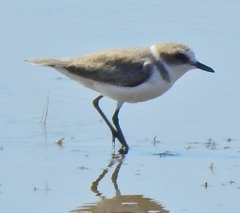Kentish plover
Anarhynchus alexandrinus alexandrinus
Aves Anarhynchus alexandrinus alexandrinus, commonly known as the Kentish Plover or Chorlitejo Patinegro in the Comunidad Valenciana, is a small and charming shorebird frequently observed along coastal areas. Here, it is often seen scurrying on sandy beaches and salt marshes, offering birdwatchers and nature enthusiasts an exciting glimpse into its life and habits.
- Appearance: The Kentish Plover is a petite bird, with a body length typically ranging from 15 to 17 centimeters. It showcases a distinctive plumage, with a light brown to sandy-grey upper body, white underparts, and a notable black band across its forehead. The distinguishing black markings around the neck and over the eyes add to its character, helping in its identification.
- Habitat: This species is often found in sandy beaches, mudflats, and estuaries, thriving in open landscapes where it can nest and forage. In the Comunidad Valenciana, it is particularly fond of coastal areas, making it an important part of the local biodiversity.
- Behavior: The Kentish Plover feeds mainly on insects, small crustaceans, and marine worms, which it skillfully plucks from the sand and shallow waters. It is known for its characteristic stop-start running motion as it searches for prey, a behavior that is both captivating and efficient for its feeding style.
- Breeding: During the breeding season, which typically occurs from April to June, the Kentish Plover constructs a simple ground nest, often camouflaged amidst pebbles or vegetation. Both parents share in the incubation duties, demonstrating a cooperative breeding strategy crucial for the survival of their young in exposed environments.
- Conservation: While the species is not globally threatened, the Kentish Plover's populations are vulnerable to habitat loss and disturbances, particularly in coastal regions. Conservation efforts in the Comunidad Valenciana aim to preserve its natural habitats, ensuring the survival and prosperity of this delightful bird.







